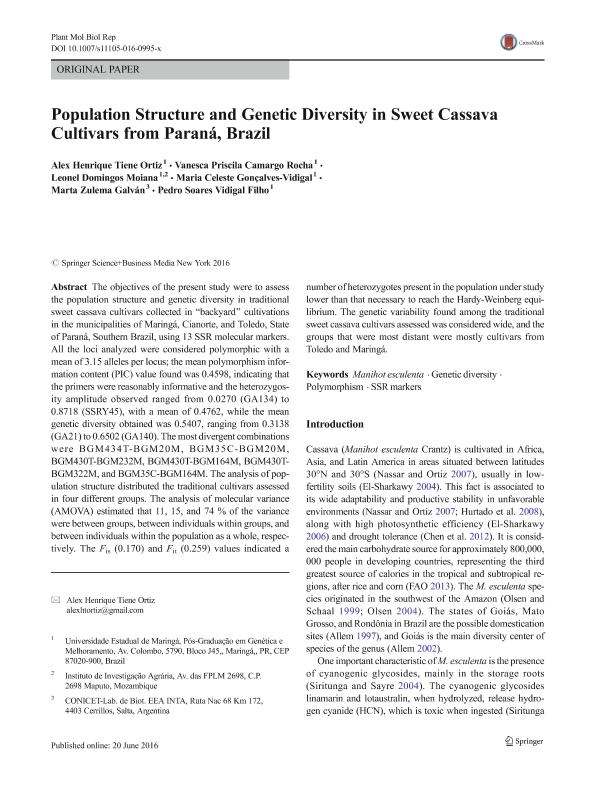Mostrar el registro sencillo del ítem
dc.contributor.author
Ortiz, Alex Henrique Tiene
dc.contributor.author
Rocha, Vanesca Priscila Camargo
dc.contributor.author
Moiana, Leonel Domingos
dc.contributor.author
Gonçalves Vidigal, Maria Celeste
dc.contributor.author
Galván, Marta Zulema

dc.contributor.author
Vidigal Filho, Pedro Soares
dc.date.available
2018-09-11T20:20:38Z
dc.date.issued
2016-12
dc.identifier.citation
Ortiz, Alex Henrique Tiene; Rocha, Vanesca Priscila Camargo; Moiana, Leonel Domingos; Gonçalves Vidigal, Maria Celeste; Galván, Marta Zulema; et al.; Population Structure and Genetic Diversity in Sweet Cassava Cultivars from Paraná, Brazil; Springer; Plant Molecular Biology Reporter; 34; 6; 12-2016; 1153-1166
dc.identifier.issn
0735-9640
dc.identifier.uri
http://hdl.handle.net/11336/59172
dc.description.abstract
The objectives of the present study were to assess the population structure and genetic diversity in traditional sweet cassava cultivars collected in “backyard” cultivations in the municipalities of Maringá, Cianorte, and Toledo, State of Paraná, Southern Brazil, using 13 SSR molecular markers. All the loci analyzed were considered polymorphic with a mean of 3.15 alleles per locus; the mean polymorphism information content (PIC) value found was 0.4598, indicating that the primers were reasonably informative and the heterozygosity amplitude observed ranged from 0.0270 (GA134) to 0.8718 (SSRY45), with a mean of 0.4762, while the mean genetic diversity obtained was 0.5407, ranging from 0.3138 (GA21) to 0.6502 (GA140). The most divergent combinations were BGM434T-BGM20M, BGM35C-BGM20M, BGM430T-BGM232M, BGM430T-BGM164M, BGM430T-BGM322M, and BGM35C-BGM164M. The analysis of population structure distributed the traditional cultivars assessed in four different groups. The analysis of molecular variance (AMOVA) estimated that 11, 15, and 74 % of the variance were between groups, between individuals within groups, and between individuals within the population as a whole, respectively. The Fis (0.170) and Fit (0.259) values indicated a number of heterozygotes present in the population under study lower than that necessary to reach the Hardy-Weinberg equilibrium. The genetic variability found among the traditional sweet cassava cultivars assessed was considered wide, and the groups that were most distant were mostly cultivars from Toledo and Maringá.
dc.format
application/pdf
dc.language.iso
eng
dc.publisher
Springer

dc.rights
info:eu-repo/semantics/openAccess
dc.rights.uri
https://creativecommons.org/licenses/by-nc-sa/2.5/ar/
dc.subject
Genetic Diversity
dc.subject
Manihot Esculenta
dc.subject
Polymorphism
dc.subject
Ssr Markers
dc.subject.classification
Agricultura

dc.subject.classification
Agricultura, Silvicultura y Pesca

dc.subject.classification
CIENCIAS AGRÍCOLAS

dc.title
Population Structure and Genetic Diversity in Sweet Cassava Cultivars from Paraná, Brazil
dc.type
info:eu-repo/semantics/article
dc.type
info:ar-repo/semantics/artículo
dc.type
info:eu-repo/semantics/publishedVersion
dc.date.updated
2018-09-04T17:56:18Z
dc.identifier.eissn
1572-9818
dc.journal.volume
34
dc.journal.number
6
dc.journal.pagination
1153-1166
dc.journal.pais
Estados Unidos

dc.journal.ciudad
Nueva York
dc.description.fil
Fil: Ortiz, Alex Henrique Tiene. Universidade Estadual de Maringá; Brasil
dc.description.fil
Fil: Rocha, Vanesca Priscila Camargo. Universidade Estadual de Maringá; Brasil
dc.description.fil
Fil: Moiana, Leonel Domingos. Universidade Estadual de Maringá; Brasil. Instituto de Investigação Agrária; Mozambique
dc.description.fil
Fil: Gonçalves Vidigal, Maria Celeste. Universidade Estadual de Maringá; Brasil
dc.description.fil
Fil: Galván, Marta Zulema. Consejo Nacional de Investigaciones Científicas y Técnicas; Argentina. Instituto Nacional de Tecnología Agropecuaria. Centro Regional Salta. Estación Experimental Agropecuaria Salta; Argentina
dc.description.fil
Fil: Vidigal Filho, Pedro Soares. Universidade Estadual de Maringá; Brasil
dc.journal.title
Plant Molecular Biology Reporter

dc.relation.alternativeid
info:eu-repo/semantics/altIdentifier/doi/http://dx.doi.org/10.1007/s11105-016-0995-x
dc.relation.alternativeid
info:eu-repo/semantics/altIdentifier/url/https://link.springer.com/article/10.1007%2Fs11105-016-0995-x
Archivos asociados
